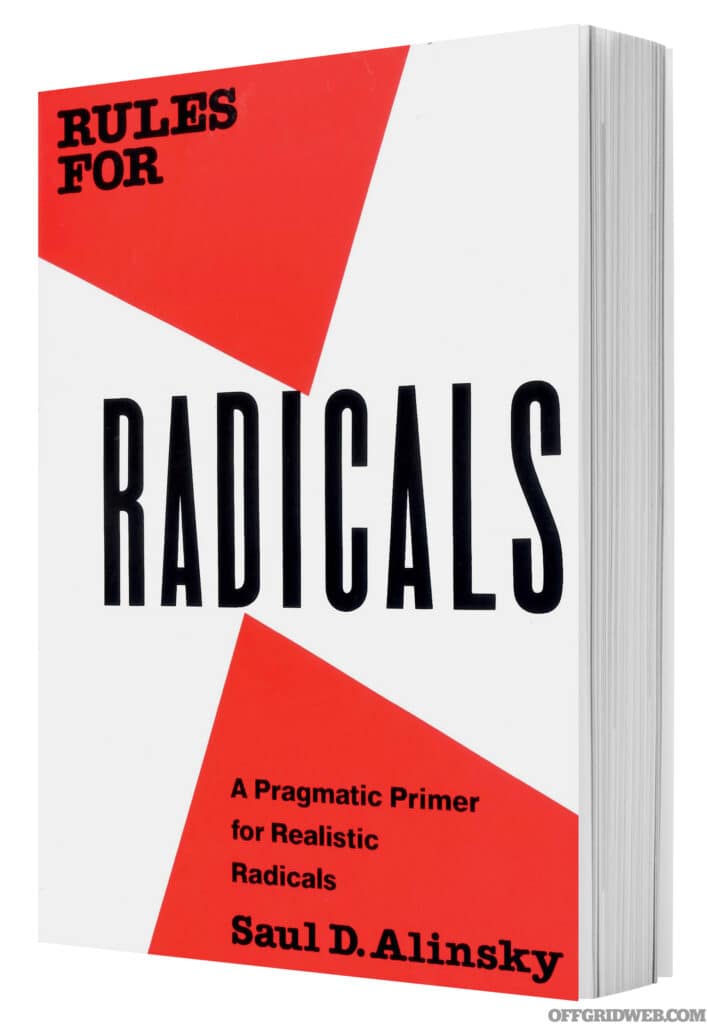RECOIL OFFGRID Preparation Book Review: “Rules for Radicals: A Pragmatic Primer for Realistic Radicals” By Saul D. Alinsky
Saul Alinsky’s last book, or manual, Rules for Radicals: A Pragmatic Primer for Realistic Radicals, welcomes readers into revolutionary tactics and guidelines. This book is designed to assist organizers and activists in reshaping the world. In his first chapter, “The Purpose,” he specifically outlines his main accomplishment: “In this book we are concerned with how to create mass organizations to seize power and give it to the people; to realize the democratic dream of equality, justice, peace, cooperation, equal and full opportunities for education, full and useful employment, health, and the creation of those circumstances in which man can have the chance to live by values that give meaning to life.”
This might sound promising, especially when he reminds us of our own American Revolution. However, he soon explains, “today revolution has become synonymous with communism while capitalism is synonymous with status quo.” Although he claims this is “a revolutionary handbook not cast in a communist or capitalist mold,” he also expresses a strong desire to “use power for a more equitable distribution of the means of life for all people.” He leads his readers on a journey into the ethics of revolution, how to properly educate future organizers, and most importantly, the tactics in the fight for change. This is Alinksy’s playbook to power “for the Have-Nots of the world.”
The controversial book begins with Alinsky dedicating his work to the first successful radical who “won his own kingdom” — Lucifer. This book is a siren song for the glittering ideology of revolution; a step-by-step guide for inciting conflict in communities, organizations, and society in order to produce change. Much of Alinsky’s language is divisive using words like “us,” “they,” “comrades,” “we,” “the other side,” etc. Who are these “other” people he is referring to throughout his book? Well, he boldly states, “If we don’t encourage them to form alliances with us, they will move to the right.” He clearly illustrates the manual is intended for a certain audience, not truly for everyone.
Alinksy divides classes into the Haves, Have-Nots, and the Have-a-Little, Want Mores. He’s interested in the Have-Nots obtaining power. He begins establishing a plan in which they can be easily agitated if they feel they can obtain power over the Haves. Alinksy even says, “An organizer must stir up dissatisfaction and discontent; provide a channel into which the people angrily pour their frustrations” and “agitate to the point of conflict.” “He does not have a fixed truth — truth to him is relative and changing.” In his last chapter, “The Way Ahead,” the demographic he targets is “America’s white middle class” — previously their enemy and now an important ally. In this chapter, the tone becomes more pressing and urgent, more aggressive — a call to action for the average American to assist in this revolution — does any of this sound familiar yet?
Remember, words are vital for revolution. That’s why three of the most important chapters are “A Word About Words,” “Tactics,” and “The Way Ahead,” which all have the same eerie forecast of present-day America. “A Word About Words” sounds familiar to our modern conversation surrounding rhetoric. He reminds readers that words are powerful and can be molded into new meanings for revolutionary causes. “Tactics” is also an unsettling look into our present divided situation. He lays out 13 rules that are worth studying carefully (look them up). “The Way Ahead” lays out the road ahead from 1971 onward.
Rules for Radicals should be read by anyone who wishes to fully understand today’s intensely polarized social and political climate. Although the book is littered with dense, intellectual literary sources, sifting through Alinsky’s takeaways from each reference makes his message crystal clear. It’s important to analyze each point carefully and to continually reestablish Alinsky’s message on conflict: “[The organizer] must search out controversy and issues, rather than avoid them, for unless there is controversy people are not concerned enough to act.”
Make no mistake, this book is designed to ignite conflict, division, and revolution. But, if read and understood, it levels the playing field by offering insight into the “enemy,” as he so often refers. Alinsky is skilled in the art of rhetoric — at times, his words appear sympathetic and trustworthy, but do your best to read beyond the seductive veneer. As a tool, this book is helpful in understanding the mentality of the “movement” Alinsky promotes. If you read it with the intention of learning about radical ideology, it’ll better help you prepare for the possible outcome it’s trying to achieve.

Book & Author
Rules for Radicals: A Pragmatic Primer for Realistic Radicals

By Saul D. Alinsky
Publisher
Vintage
MSRP
$12 Paperback (Amazon)
URL
Pages
224
Rating
>Thrive
Survive
Die
 STAY SAFE: Download a Free copy of the OFFGRID Outbreak Issue
STAY SAFE: Download a Free copy of the OFFGRID Outbreak Issue
No Comments